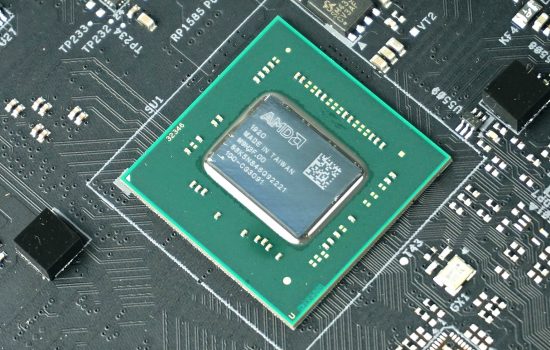Gigabyte RX 7900 GRE Gaming OC 16G in detail
The most “lightweight” AMD Navi 31 (XL) GPU, the slowest memory subsystem, but also the lowest price. That’s the RX 7900 GRE compared to the RX 7900 XT. This Radeon is also noticeably cheaper compared to the RTX 4070 Super, although the GeForce’s power efficiency is more favorable. The gaming performance of the RX 7900 GRE (RTX 4070S), meanwhile, is comparable. That is, as long as you won’t miss ray-tracing graphics.
Radeon RX 7900 GRE graphics cards are built on the “Navi 31 XL” hybrid GPU of the RDNA 3 architecture. It uses a big GCD chiplet from the high-end Navi 31, which has 80 CUs enabled, just four fewer than the Radeon RX 7900 XT. However, unlike Navi 31, it is housed in a smaller package with fewer contacts and is only connected via a 256-bit bus. Thus, only four MCD chipsets and 64 MB Infinity Cache are active. The primary target of this version of the GPU was gaming laptops (it is sold as Radeon RX 7900M). In the context of the Radeon RX 7900 GRE, we can probably talk about a sort of secondary use.
In the Radeon lineup, the RX 7900 GRE is fairly close to the RX 7800 XT, which it matches with 16GB of memory with a 256-bit wide bus. Although the Radeon RX 7800 XT has only 3840 shaders (60 CUs), significantly less than the RX 7900 GRE (with 5120 shaders), it has a relatively high clock speed. AMD officially puts the gaming clock speed of the GPU in the RX 7900 GRE at a conservative 1880 MHz. Our tested variant (Gigabyte Gaming OC) comes with a more aggressive boost, but it’s still a simpler design. But with respect to the best possible price-performance ratio, that’s a good thing – you aren’t paying extra for things that don’t affect the speed, and if you do, it’s only a minimal amount.
Lower factory clock speeds here also mean relatively better overclocking options. However, when trying to catch up with the Radeon RX 7900 XT‘s performance using OC, the memory could be a bottleneck, as with a narrower bus and 18.0GHz clock speed, it has a bandwidth of “only” 576GB/s (compared to the about 800GB/s of the RX 7900 XT’s 20GHz memory with a 320-bit bus).
Gigabyte RX 7900 GRE Gaming OC 16G in detail
The only RX 7900 GRE model Gigabyte has is in the Gaming (OC) version. So this is the lowest range of Gigabyte graphics cards, but the official boost clock (2391 MHz) is still 146 MHz above the reference one.
And the Windforce (3X) cooler with three fans is also quite robust in this case. Otherwise, it wouldn’t work too well, since the TGP is over 260 W. How much exactly corresponds to maximum performance, Gigabyte does not specify. But it’s not a big deal – we’ll measure the power consumption. The only important thing here is a note about the cooler, which is bigger despite the fact that you’re dealing with a relatively “cheaper” design (weighing up to 1315 grams).
The RX 7900 GRE Gaming OC 16G graphics card is also quite long at 302mm. In width, from the PCIe slot towards the other side, to the cooler cover, it’s about 130 mm. With those, there is some potential for mounting in narrower cases, or in dual-chamber cases with vertically split interiors. These often have the chamber that houses the graphics card narrower. For those that count on the graphics card being formatted according to the width of the PCI Express plug, this model will also be too wide.
As for height, expect to lose three slots with the RX 7900 GRE Gaming OC 16G. There are plenty of significantly thicker graphics cards out there, but there are also thinner ones, though those are often weaker or at least get hotter, unless they’re also flat out noisier.
The backplate is metal, made of aluminum, and even in the Gaming line, Gigabyte has set a higher “standard” than cheaper and less powerful models with weaker GPUs.
External power supply is via two 8-pin PCIe connectors. These are more deeply recessed into the body of the graphics card, which increases the width only by the thickness of the cable (i.e. without the connector), which has a positive impact on compatibility with computer cases.
A short distance from the external power connectors is the BIOS switch. This card has two, one with the “OC” profile, the other “Silent”. While we traditionally test on “OC”, which is also the default position, it’s fair to note that the graphics card runs a bit quieter on “Silent”. At comparable GPU clock speeds, we recorded slightly lower fan speeds with it – about 1300 rpm (compared to 1500 rpm in “OC”), which naturally results in a hair lower noise level, but at the expense of higher temperature. It’s still low enough, however, as the cooler has a pretty good headroom.
The heatsink structure consists of a traditional copper coldplate, from which the heat is transferred by seven heatpipes to the heatsink with relatively dense finning. From fin to fin it is approximately 14 mm, with a thickness of 0.3 mm per fin.
90 mm fans with nine blades and an impeller height of 13.5 mm are used to cool the heatsink. The blades here are relatively short and, in addition, feature “acceleration” ducts on the front of the trailing edges. Their usefulness is supposed to lie in the suppression of unwanted microturbulence at the fan intake, which should increase airflow while reducing noise. This is of course only minimal, no dramatic changes are made by this modification. Cosmetics.
Even though the RX 7900 GRE Gaming OC 16G is both a heavier and longer graphics card, you won’t find a support brace in the accessories. In fact, you won’t find anything in it at all apart from a “quick guide” with basic installation instructions – the price, in short, is meant to be as low as possible.
But there are some small flourishes that Gigabyte deems appropriate in this price class. It’s a Radeon logo in the back and then a Gigabyte logo in the middle with ARGB backlighting (manageable via the RGB Fusion 2.0 app).
Please note: The article continues in following chapters.
- Contents
- Gigabyte RX 7900 GRE Gaming OC 16G in detail
- Table of parameters
- Methodology: performance tests
- Methodology: how we measure power draw
- Methodology: noise and sound measurement
- Methodology: temperature tests
- Test setup
- 3DMark
- Age of Empires II: DE
- Assassin’s Creed: Valhalla
- Battlefield V
- Battlefield V with DXR
- Borderlands 3
- Control
- Control with DXR
- Counter-Strike: GO
- Cyberpunk 2077
- Cyberpunk 2077 with DXR
- DOOM Eternal
- F1 2020
- FIFA 21
- Forza Horizon 4
- Mafia: DE
- Metro Exodus
- Metro Exodus with DXR
- Microsoft Flight Simulator
- Red Dead Redemption 2 (Vulkan)
- Red Dead Redemption 2 (Dx12)
- Shadow of the Tomb Raider
- Shadow of the Tomb Raider with DXR
- Total War Saga: Troy
- Wasteland 3
- Overall gaming performance and performance per euro
- CompuBench (OpenCL)
- SPECviewperf 2020 and SPECworkstation 3
- FLOPS, IOPS and memory speed tests
- 3D rendering 1/2 (LuxMark and Blender@Cycles)
- 3D rendering 2/2 (Blender@Radeon ProRender and Eevee)
- Photo editing (Adobe Photoshop, Lightroom and Affinity Photo)
- Broadcasting (OBS and Xsplit)
- Password cracking
- GPU clock speed
- GPU and VRAM temperatures
- Net graphics card power draw and performance per watt
- Analysis of 12 V rail power supply (higher load)
- Analysis of 12 V rail power supply (lower load)
- Analysis of 3.3 V rail power supply
- Noise level
- Frequency response of sound
- Conclusion

























